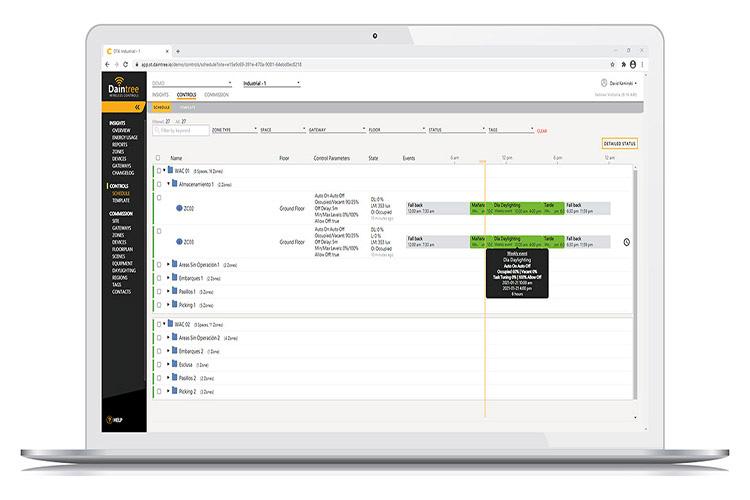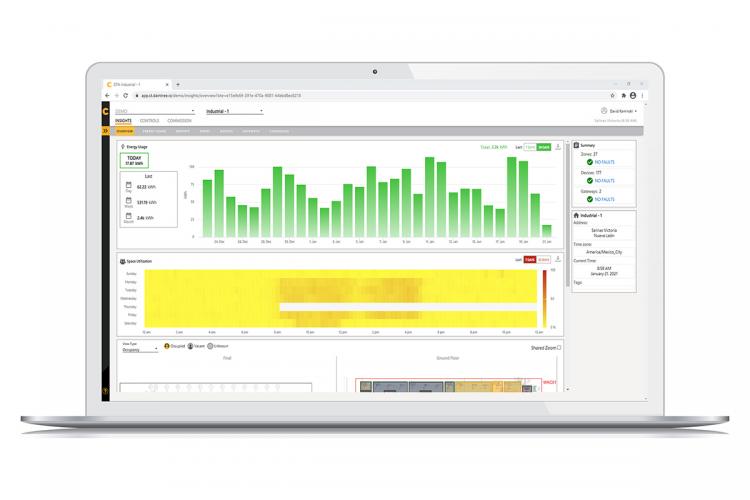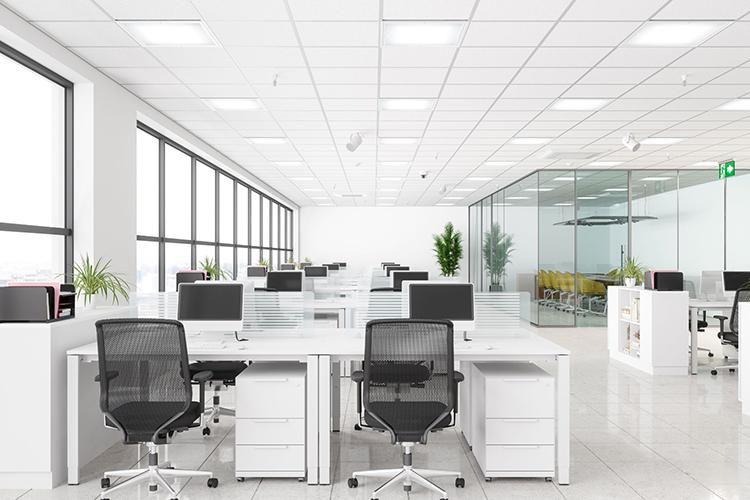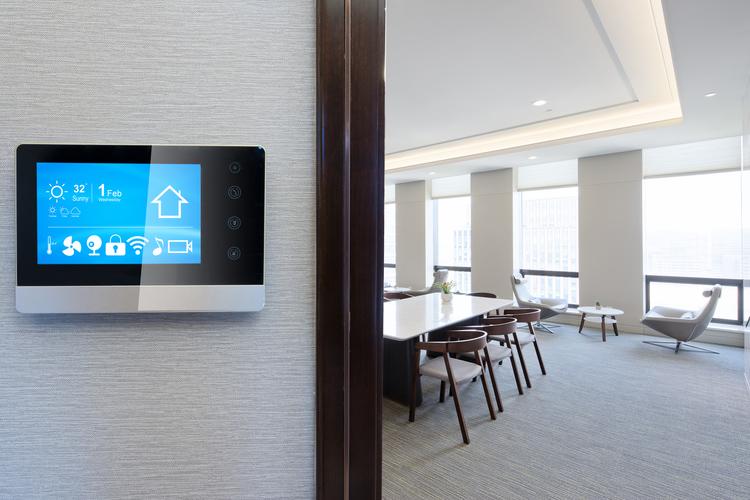Energy-Saving Controls Strategies for Commercial Lighting
Energy-Saving Controls Strategies for Commercial Lighting
INTRODUCTION
More Control. More Than Control.
Over 30% of energy consumption in a commercial building is from lighting. That equals over $100 billion in lighting energy spent each year on commercial buildings across the world. Much of that is wasted energy, like when lights or other phantom loads like printers or monitors are left on with no one in the room or if the room is overlit.
Not only that, but energy codes put in place to save energy and take the strain off of the energy grid, such as IECC, Title 24, ASHRAE 90.1 and NECB in Canada, are requiring the use of lighting controls in commercial spaces for new construction and renovation projects. Technology in controls exists to address this. Get that wasted energy — and the dollars spent on it — back.
Lighting controls are a convenient, intuitive way to save energy and money. Start with scalable and flexible solutions that allow you to control lighting in a single room, multiple rooms and even multiple buildings. Go beyond that to integrate lighting to your building management system, where systems “talk” to each other and provide real-time data that helps you make smart business decisions and drive productivity.
What controls systems, technology and solutions are out there?
Let’s take a look.
A RANGE OF REAL-WORLD, REAL-TIME SOLUTIONS
Types of Lighting Controls Systems
A “lighting controls solution” can be as simple as a wall switch. Or lighting can be automated with an occupancy sensor that turns the lights on or off when someone enters or leaves a room. And vacancy sensing automatically turns lights off when a room is empty after a set period of time. More advanced systems can go beyond lighting and can control HVAC, plug receptacles and other Building Management Systems (BMS). This saves energy and money. But it only scratches the surface.
A wealth of lighting controls technologies, systems and components is on the commercial market today, ranging from simple room-based controls to advanced networked solutions for multisite locations and campuses.
When implemented, these scalable and flexible solutions can save you energy, enhance your business today and evolve with your future needs.
Simple Controls: Right From the Start
Lights go on when someone enters a room. They turn off shortly after they leave. These room-based controls are individual components that provide a simple lighting controls strategy ideal for small to mid-sized commercial spaces.
For example, an individual occupancy sensor can be connected via low-voltage wiring to a set of light fixtures in a room. This process can be repeated in the next room and so on. The result is to add automated occupancy control to each of those rooms individually.
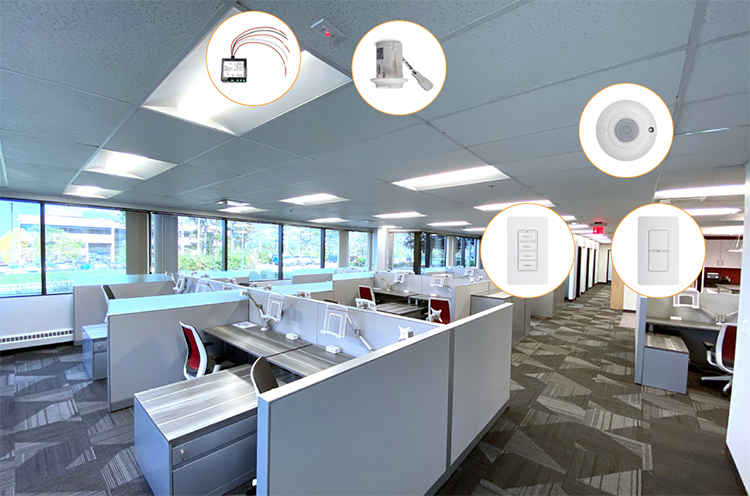
Centralized Controls: A Hub of Energy Savings
The next step up in capabilities is a centralized controls system. In these systems, each lighting controls component or node (sensors, wall switches, fixtures and so on) is connected to a centralized gateway or hub. As a result, lighting can be managed from a centralized controller or app as a system or network.
Centralized systems, like Daintree Networked, allow the control and scheduling from a centralized platform like Daintree Controls Software (DCS) web application and control an entire building, campus or network of locations worldwide.
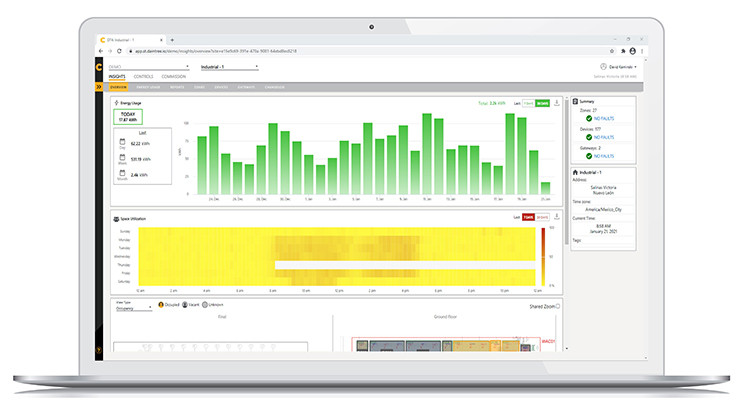
These systems typically combine a discrete set of controls capabilities or strategies that include scheduling, occupancy and daylighting and provide a physical interface for controlling any device connected to the system.
Next-Generation Controls: Putting Potential in Place
Wireless networking can enable larger-scale systems with controls that can be accessed from anywhere and adjusted without physical wiring.
Some advanced controls can also integrate with nonlighting Building Management Systems (BMS) products to drive savings that go beyond lighting into areas such as HVAC and plug loads for a comprehensive set of energy-monitoring and management tools, all with centralized control. Controls systems can be your way in to the world of IoT. The open architecture and read/write capabilities eliminate the restrictions of proprietary systems, so a single controls system can utilize control devices from a variety of vendors and app developers. The connected controls systems allow further connectivity with IoT devices. These devices can integrate with a variety of data analytics and app development for commercial productivity increases.
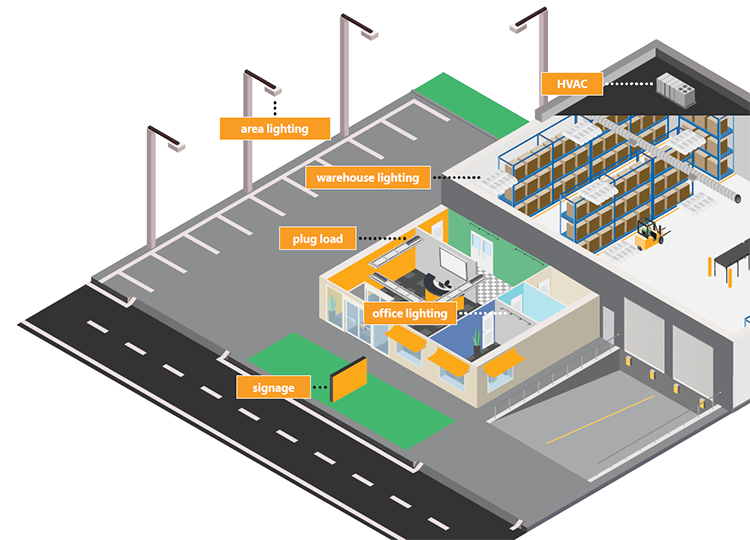
LIGHTING-FOCUSED. DETAIL-DRIVEN.
Common Lighting Controls Strategies
Dimming, occupancy sensing and scheduling are common lighting strategies that deliver surprising results to your bottom line. Beyond the energy savings that result as lighting is used when and where it should, these common strategies — applied alone or used together — add to occupancy comfort and a just-right approach to lighting.
The strategies themselves are a valuable addition to any building lighting approach you have now, and the technology continues to evolve to meet your ongoing and upcoming needs.
Dimming Done Right
Lights give 100%. Sometimes, it’s wise for them to give a little less. Dimming the light to a fraction of its brightness will also use a fraction of the energy, which in turn propels related lighting strategies to reduce energy usage even more.
Many lighting power supplies such as ballasts and LED drivers enable fixtures to be dimmed. The exact relationship between the brightness and the power used depends on the unique profile of the power supply.
The easiest approach? Pairing dimming fixtures with a dimmer switch for manual dimming control. Meanwhile, you can choose dimming capabilities that modulate from step functions to full, smooth control over precise light levels.
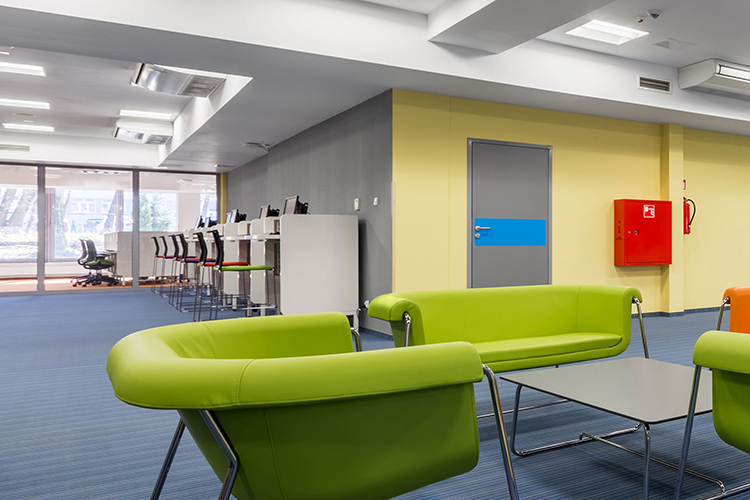
Occupancy Sensing in Motion
The lights go on when you enter. They go off shortly after you leave. And may go off if you sit still for too long.
Occupancy sensing is perhaps the most common of all lighting controls strategies. A motion sensor detects movement within its field of coverage, using Passive Infrared (PIR), ultrasonic or other sensing technologies. Based on movement detected––or a lack of it––for a predefined period of time, lights can be automatically turned on or off. When a space isn’t in use, the lights won’t be either.
More sophisticated controls include settings such as on/off levels, time delays and more to be dynamically set or changed based on time, location and other inputs. For example, they can be programmed to Auto-On, Manual-On and Auto Partial-On, depending on your needs or the code requirements for the application space.
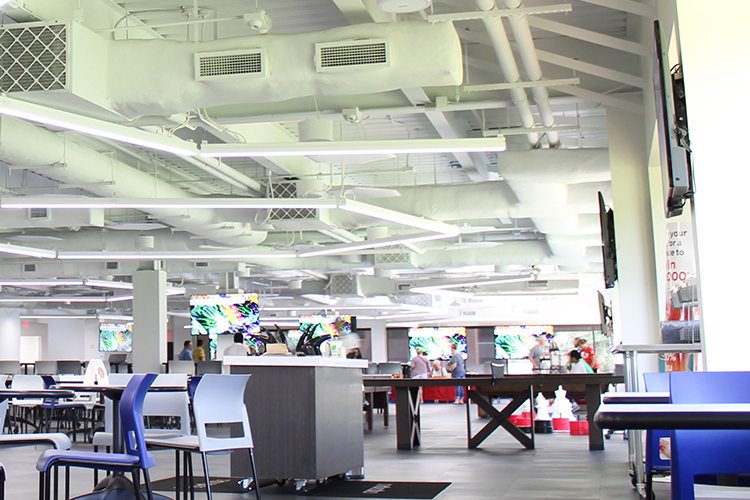
SYNCING UP WITH SAVINGS
Advantages of Advanced Controls
Advanced wireless lighting controls help to create a better, longer-term impact to your bottom line. While each individual controls strategy alone provides benefits, when applied together these savings accumulate and come from several sources:
- Reduced energy usage by eliminating unnecessary lighting through commonly adopted controls strategies like occupancy sensing, scheduling and more.
- Daylight harvesting to reduce lighting and energy use indoors when ambient sunlight is available through large windows or skylights.
- Reduced time and labor associated with managing and installing lighting.
- Government sustainability programs — like Net-Zero and LEED — and utility incentives for greater energy reduction.
Achieving Net-Zero
As a commitment to do their part in helping reduce the adverse effects of climate change, ambitious companies are taking immediate actions to reach net-zero greenhouse gas emissions by 2030. The application of energy-efficient lighting solutions with advanced controls is an ingredient to a menu of actions companies can take to get there.
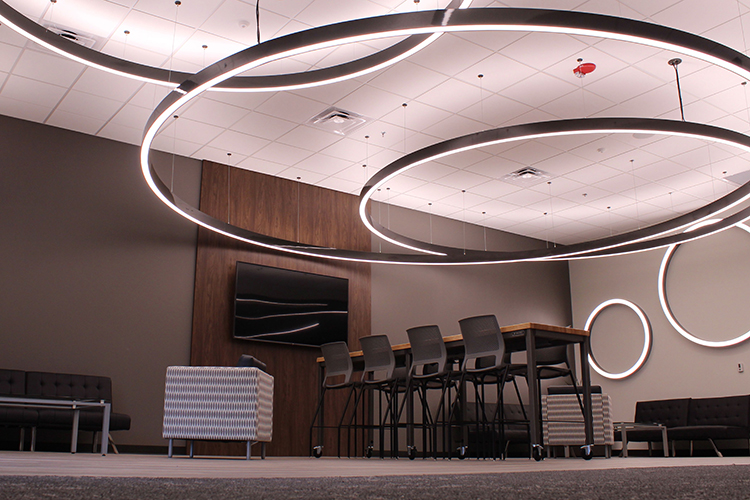
Control, Comfort, Certification and Compliance
Going beyond basic controls leads to benefits that advance your business. The intelligence of advanced controls systems delivers the following on top of financial savings.

Greater centralized control
This control and visibility over your lighting and other energy loads drive better management and reporting.

Occupant comfort
The most intelligent lighting controls solutions enable lighting that automatically or manually adapts to occupant needs. Greater comfort can lead to improved productivity.

Green certifications
Advanced controls systems can provide valuable points and credits — well beyond credits from basic controls — toward LEED, Net-Zero and other similar sustainability programs.

Regulatory compliance
Regulatory measures such as IECC, ASHRAE 90.1 and California’s Title 24 are increasingly requiring more advanced lighting controls measures, which basic controls won’t be able to meet over time.
BALANCING SAVINGS WITH COMFORT IS A CRITICAL FUNCTION THAT REQUIRES AN ADAPTABLE SYSTEM.
Scheduling Time in Space
Whether it’s after store hours or when the workday at the office or on the floor is done, scheduling is another method of eliminating unnecessary lighting usage when buildings are normally free of occupants.
Most centralized lighting controls systems provide some form of lighting schedule. The simplest version is a system that automatically turns off the lights after work hours. Scheduling enables businesses to more conveniently fulfill requirements to turn lights off an hour after closing and turn them back on an hour before opening. This visually informs customers of operating hours while curbing light pollution in environments that adhere to dark-sky initiatives.
Other systems allow local user override of the schedule via a wall switch. The more sophisticated systems can create flexible scheduling or dusk-to-dawn scheduling. Facility managers can revise lighting strategies based on time of day, day of the week, time of the year or changing hours of operation. Plus, an intelligent system can take into account factors such as daylight saving time.
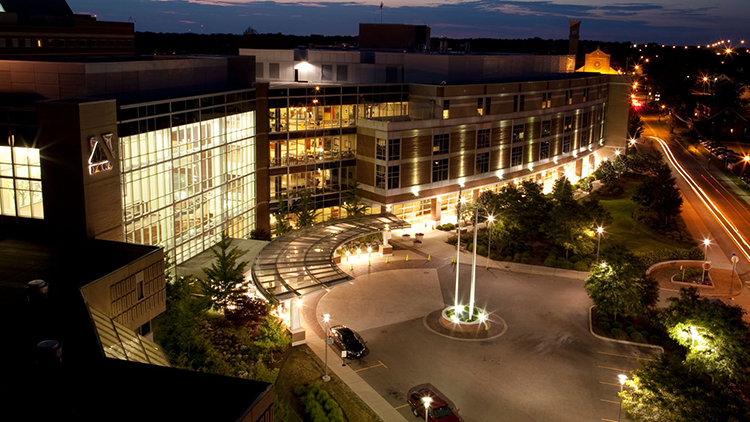
FIVE TO KNOW
Advanced Lighting Controls Strategies
While not as common now, the following five strategies are being used in more places as building managers discover the added and ongoing ROI they bring. These advanced — and inevitable — strategies are fast becoming the standard and are further “ways in” to a more intelligent enterprise.
-
Daylight Harvesting
When ambient daylight from windows and skylights is available, artificial light levels reduce automatically. Also known as daylighting, these systems typically utilize a photocell sensor that measures ambient light. The reading from the sensor triggers an algorithm that determines the appropriate level of artificial light — or whether the lights can be turned off altogether.
A PROPERLY DESIGNED DAYLIGHTING SYSTEM CAN PROVIDE SUBSTANTIAL SAVINGS IN WINDOW-FACING AREAS.
-
Task Tuning
Lighting needs vary across needs for how the space is used in a day; the same space may require different levels of light. Task tuning is when maximum light output of individual spaces is reduced to precisely meet occupant needs. Task tuning leverages the daylight light levels to ensure work areas and surfaces are evenly lit.
Some controls systems can create lighting zones and determine a “tuned” maximum light level lower than 100%. Someone working with a computer monitor all day may not need the designed light level, so their area could be tuned to a maximum level of 70%.
-
Demand Response (DR)
Don’t just save money. Earn it by reducing peak energy demand at key times and being reimbursed by utilities to do so. Some utility companies in densely populated areas try to better distribute their loads and reduce the demand for energy at peak need times, such as hot summer days. Lighting controls systems can help by automatically reducing lighting load during those times in response to a signal from the utility.
DR is required in codes like Title 24. DR reduces strain on the energy grid. Governing the energy load from peak energy usage allows energy companies to manage the energy usage during peak performance to avoid service interruptions, like rolling blackouts and brownouts.
DR utility programs vary widely and may offer significant reimbursement (such as $300/kW) for making a building’s load available for reduction.
-
Personal Control
Studies have proven the positive impact of a worker’s environment — and their control over it — on their productivity and happiness. And when they’re given personal control over lighting, their energy usage tends to be lower. Plus, the intuitive nature of lighting controls through dimmers, scene switches and digital touchscreen displays makes this personal control easier to achieve.
-
Energy Management
Utilize a software system that enables a building or facilities manager to visualize, report on and adjust their energy usage. Centralized energy management software tools provide the capability to test and measure the success of lighting controls. Energy management saves energy over time by providing ongoing improvements to all of the other controls strategies.
Measuring building energy usage related to occupancy data might show the office’s kitchen area is occupied throughout the day but only for short periods. The system could recommend reducing the occupancy-based off-delay in this area from 30 to 10 minutes and would measure the additional savings that result.
DOING MORE THAN REDUCING ENERGY USAGE
Lighting-Related Controls Strategies
Automated Maintenance: Respond and Anticipate
By monitoring and measuring energy usage at individual fixtures, some controls systems, such as Daintree® Networked, can let you know when a sensor or component is malfunctioning. This information can be used to anticipate when maintenance will be required and alert you. Beyond that, some systems can manually or automatically reconfigure in the case of a failure. For example, if an occupancy sensor fails, the lights can be reassociated with a neighboring sensor until maintenance replaces it.
This information can be used in an energy management system to improve maintenance scheduling while reducing its frequency and cost of lighting maintenance.
BMS Integration: Beyond the Bulb
Some advanced lighting controls systems integrate with a facility’s Building Management System (BMS), typically via BACnet or another open protocol. The user interface of the BMS can provide integrated controls and management functions, resulting in reduced management overhead and the associated lower cost for buildings that want to manage HVAC, plug load, fans, compressors or refrigeration units and other functions from a single console.

SENSING MORE
Beyond Lighting
Temperature, Humidity, CO2 and Other Environmental Monitoring
If things get too hot, take control. Several emerging applications tap into environmental monitoring sensors to report on conditions in a facility and trigger alerts if those conditions exceed a threshold. For example, closely tracking temperature and humidity in data centers and server rooms to avoid unplanned outages. Plus, temperature and humidity sensors can be added to the network and report real-time data.
Wireless Thermostats
Typically thermostats and other HVAC devices are managed by hours of operation. Integrating HVAC with a lighting controls network allows you to lower the heating and air conditioning when occupants leave the space. This saves additional energy within the building ecosystem. Alerts and reminders can also be set to monitor the health of the system.
ON A CENTRALIZED CONTROLS SYSTEM, YOU CAN ADD APPLICATIONS ONTO AN EXISTING NETWORK AND MONITOR AND REPORT ALL ENERGY USAGE FROM ONE COMMON SOFTWARE PLATFORM WITHOUT THE NEED TO BUILD OUT A NEW DEDICATED INFRASTRUCTURE.
Plug Load Control
Plug loads are an area of energy usage that represents a significant amount of energy waste. To reduce this waste, devices such as monitors or lamps that would be plugged into a standard outlet receptacle are instead plugged into a specialized “plug load controller.” These nonessential loads can then be managed based on location occupancy.
For example, a plug load controller can be set to automatically turn off desk lamps, printers, monitors or space heaters whenever the user leaves his desk, reducing wasted usage and the “vampire or phantom power” that some devices draw even when off.
Other Independent Building Systems
As with environmental sensors, some standards-based controls systems have the capability to add control over a variety of other devices such as automated window blinds, industrial fans and security systems. By providing centralized control over these devices and lighting, these advanced building networks deliver greater control from a single integrated solution and interface.
FOUR MORE
Key Attributes of the Most Advanced Controls Strategies
Not every controls system enables all of the strategies mentioned here. While most systems offer a subset, many are constrained due to their choice of technology, making some of the most valuable strategies impossible to implement. For example, a lighting controls system that isn’t networked will not be able to provide a centralized controls interface.
In order to get the most out of a potential controls system purchase and enable all of the above strategies, here are some of the key attributes to pursue.
-
Intelligence
Intelligence in a controls system typically means a combination of multiple related attributes:
Flexible configuration that enables facilities managers to more accurately adapt to conditions and occupant needs. An intelligent controls system usually includes a powerful and feature-rich user interface for setting or changing controls.
Automated controls and reporting help make decisions to determine energy controls strategies that are right for your space. For example, an intelligent controls system could combine ambient light readings with time of day, day of week, location, user preference and more to determine and set the appropriate light level.
The ability to measure results and the means to use that data to improve results.
WITH NET-ZERO AS A PREVALENT GOAL FOR MANY COMPANIES, IT'S IMPORTANT TO SEE WHAT AND HOW THE ENERGY IS PERFORMING SO THEY CAN MAKE DECISIONS. CONTROLS INTELLIGENCE ENABLES DECISIONS THAT ARE BEST FOR THE PRODUCTIVITY OF THEIR SPACE.
-
Open Communication
Communication is critical in a controls system; the system must be able to receive data from devices and issue commands to fixtures. The language used to control these messages can take many forms, though most frequently the communications language is proprietary and created by the manufacturer of the controls system. In an open system, a manufacturer chooses an existing communications language, and their products can communicate directly with other manufacturers' products and systems such as BMS, API, IoT devices, servers and more.
Open systems provide greater flexibility and upgradability. But the most important may be their impact on innovation. When multiple companies develop products based on the same open industry standard, customers can take advantage of all their combined innovations. This is how lighting controls systems can take advantage of energy savings beyond lighting and will define the future of how new integrated energy strategies will be developed.
But isn't an open system vulnerable to infiltration or hacking from outside sources? Different types of connected lighting systems pose various risks, but your provider should supply you with a system that keeps data close, doesn't leave any gaps and has airtight read/write capabilities for IoT and API productivity tools.
PROPRIETARY SYSTEMS HAVE LIMITED THE GROWTH OF NEW AND INNOVATIVE CONTROLS STRATEGIES BECAUSE EACH VENDOR ESSENTIALLY STARTS FROM SCRATCH IN DEVELOPING THEIR OWN SYSTEM.
-
Security
Wireless devices allow open communication to grow and evolve convenience, speed and flexibility. Wireless devices allow progression of the Internet of Things (IoT), and commercial property owners will want to ensure that their infrastructure is protected with security measures that could include secured interfaces, product encryption, automatic security updates and vulnerability reporting.
Consider communication protocols like Zigbee, a global wireless communication standard for IoT applications. Used in a wide range of applications by hundreds of companies, Zigbee has been deployed in connected lighting, utility and retail applications. Zigbee Pro is the standard currently being used in the Daintree® Networked system. Zigbee Pro defines the security standard to ensure interoperability between products from different vendors. There is a single trust center within this standard that manages access and trust.
WIRELESS SYSTEMS CAN CONNECT TO DEVICES, SUCH AS PLUG LOAD CONTROLLERS AND ENVIRONMENTAL SENSORS, EASILY AS LONG AS THEY SPEAK THE SAME LANGUAGE.
-
Networked
Daintree® Networked allows centralized reporting, monitoring and scheduling across a single building, campus or network of buildings.
A networked architecture is what separates basic room level controls from true controls systems. Networking enables you to build the infrastructure for your facility to take other energy management platforms, such as BMS, HVAC, demand response and other control capabilities. Networked controls can also help to facilitate other advanced features like IoT and make it easier to manage, maintain and upgrade the system.
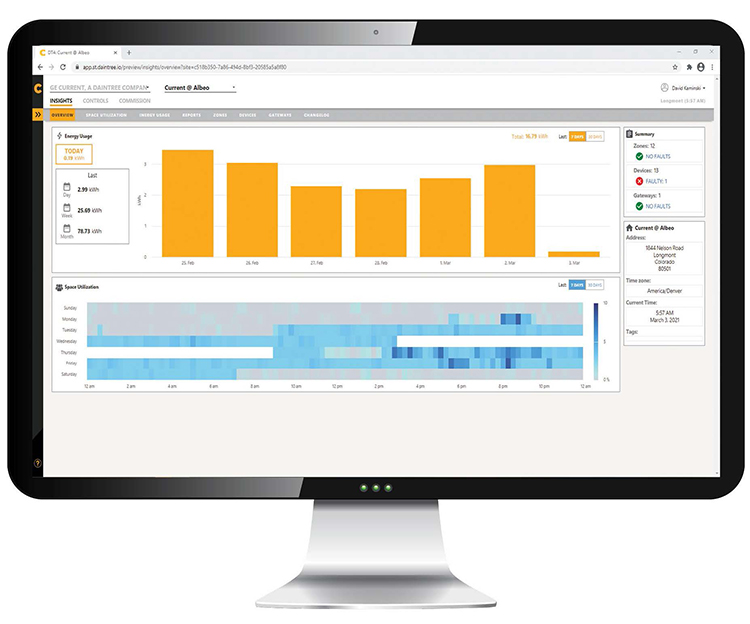
DAINTREE® NETWORKED AND DAINTREE® CONTROLS SOFTWARE (DCS) LET YOU:
Schedule lighting
Control when lights are on and off for specific times of day and in specific areas of a room.
Program the system
Commission your lighting system with software to provide greater flexibility and adjustment capabilities based on your requirements, such as maximum light levels, change in operating hours or reconfiguration of your space.
Monitor and report on energy usage
See how much energy is being utilized, at what time periods and in each location. Then have the ability to adjust the output.
Enable data utilization
DCS analyzes data in real time so you know what’s happening now to control factors as they occur, plus you can anticipate needs.
Provide an infrastructure of IoT
With open architecture, read/write capabilities and third-party applications, you can build in limitless and advanced metrics on people counting, asset tracking, heat mapping and more.
Controls Conclusion
of this potential is to go beyond the basic lighting controls strategies — using multiple energy controls strategies in tandem. There are countless emerging strategies waiting to be used and innovations yet to be discovered. Controls systems that are primed to use these new innovations are more likely to last the lifetime of your building and continue to provide value far into the future.
Discover more at our new controls page.
Get your controls plan started today.




